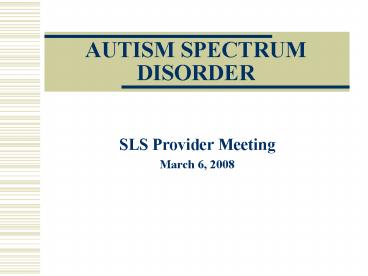AUTISM SPECTRUM DISORDER - PowerPoint PPT Presentation
1 / 16
Title:
AUTISM SPECTRUM DISORDER
Description:
AUTISM SPECTRUM DISORDER ... Housing needs to acknowledge level of skill of person and home needs to have fewer individuals Housing Options Range of options from ... – PowerPoint PPT presentation
Number of Views:140
Avg rating:3.0/5.0
Title: AUTISM SPECTRUM DISORDER
1
AUTISM SPECTRUM DISORDER
- SLS Provider Meeting
- March 6, 2008
2
People with Autism have challenges in the areas
of
- Communication
- Socialization
- Restricted/Repetitive Behaviors
3
Consumers with an autism diagnosis tend to be
younger. The average age of a consumer with
autism is 20 years. Average age of all others is
34 years.
4
Consumers with autism more likely to be male.
5
We are missing 8 of race data in one group, so
difficult to make comparison. When comparing
Hispanic Ethnicity though , no difference.
6
Consumers with autism diagnosis more often have
diagnosis of related conditions.
With autism Without autism
Mild 317 23.0 43
Moderate 318.0 21.8 24
Severe 318.1 12.8 14
Profound 318.2 4.0 10.4
Unspecd 319 2.2 6
Related conditions V79.8 36.2 3
7
Consumers with autism diagnosis are more likely
to have a medium or high behavior assessment.
Behavior Asst With autism Without autism
Low 33.3 59
Medium 58.9 36
High 7.9 6
8
The incidence of autism is
- growing at a rate of 10-17 annually.
- (Autism Society of America, 2995)
9
Common themes in literature
- Needs can develop suddenly
- Loss of natural supports (friends, educators)
- Death of parent
- Job loss
- Lack of mandates to serve
- Seeing costly emergencies.
- Dont meet eligibility criteria for DD services
due to lack of cognitive disability, but dont
have functional skills needed to live, work or
function independently. - For those who do meet criteria, lack of
appropriate supports specific to needs.
10
Common theme continued
- Needs on the service side
- Individualized services to meet behavioral,
communication and sensory challenges - Focus on development of social skills
find/maintain employment, friendships sexual
education - DVR often only service availabledont meet
needs for specific, lifelong support
11
BEST PRACTICES
- Transitioning from school
- Major difficulty gradual, limited at any one
time - Enhanced coordination care mgt, med. mgt, family
- Avoid gaps in service
- Adult staff work w/ educators
- Specialized supports in post- secondary
- Holistic supports
- Integrate seamlessly throughout day and lifespan
in work, recreation, social wrap around - Life not divided into Residential and
Employment. - Life coach to facilitate community integration
and access
12
Best practice Housing needs to acknowledge level
of skill of person and home needs to have fewer
individuals
- Housing Options
- Range of options from family home, apt, condo,
town home, private home other than group home
model - providing supports to those in family home
in-home supports and respiteis cost-effective
- Creativity in housing
- Living alone or with 2 or 3 individuals who can
share space w/o getting in each others way - Companion living
- Roommates w/o disabilities
- Host families
- Drop-in support, neighbor
13
Best Practice Housing considerations
- Matching
- Roommates leisure interests, tastes
preferences, tolerance - Support staff
- Funding
- Separate consideration for housing
- Separate consideration for support services
14
BEST PRACTICE Employment and Alternative Services
- Free up bricks/mortar for more individualized
support - One on one support during transition, then
fadeseveral yrs to see cost-savings - Individualized budgets/ programming flexibility,
responsive to changing needs, culturally
appropriate
- Emphasis on employment customized, job-sharing,
small businessconsideration to
sensory-processing - Emphasis on social skills, friendships, natural
supports, own community - Training for those who provide natural supports
- Emphasis on family
- Naturalized transportation
15
Best Practices continued
- Natural supports to achieve community membership
and maximize resources in light of funding
shortfalls - Post-secondary and training programs need
- Planning at state level Autism Services Office,
Governors Task Force- common vision and
philosophy
16
STATE LEVELPLANNING, POLICY, FUNDING
- Common vision, philosophy, policy
- Proactive strategies
- Mandated services and eligibility issues
- Funding rates based on individual need
- Collaborative funding DD, DVR, MH
- Service expansion clinical, behavioral,
transition, employment, housing - Promote best practices and service delivery
models - Start-up supplemental funding incentives for
community programming, greater staff ratios, more
staff training, - TA and professional training
- Case management w/ expertise in Autism































